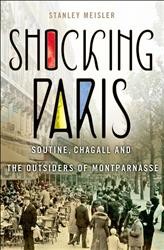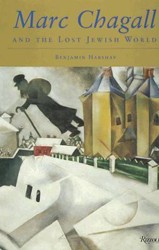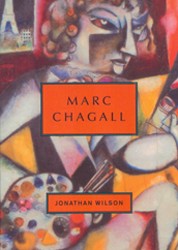In late nineteenth-century Vitebsk, Belarus, downtrodden workers struggle, parents worry, rabbis try to hold the community together, and Moishe Shagall — the gifted boy who would become Marc Chagall — begins to paint. With poetic text and dramatic pictures, author Barb Rosenstock and illustrator Mary GrandPré translate the artist’s conviction and versatility into a compelling tale about the triumph of imagination.
Chagall’s success may have seemed as improbable as a fiddler playing on a rooftop. Rosenstock pays tribute to this image of embattled Eastern European Jewry in the book’s first pages: “A parade of plodding oxen, wandering goats, and flapping hens./ Neighbors squabble, rabbis bless, a bowlegged fiddler plays on a rooftop.” In the author’s note, she cites Chagall’s own autobiography as a source for the rhythmic language she uses to narrate his life.
If Rosenstock’s challenge is to present Chagall as an inspired genius but also a dedicated craftsman, GrandPré’s is to draw in a style that reflects Chagall’s own without merely imitating his famous paintings. Her pictures blend fantasy and realism, and parallel the complex figure that Rosenstock depicts. An illustration depicts young Moishe looking through his window, observing the chaos of people and animals. The expression on his face is not one of frustration, but of dreamlike concentration; whatever he sees, he turns to art.
As a young man, Moishe rejects the future that others see for him — as a “butcher, baker, [or] blacksmith” — but Rosenstock steers clear of sentimentality by avoiding a depiction of Chagall as an angry young man reined in by tradition. An illustration reflects these different possibilities that await him if he doesn’t succeed as an artist: a wooden dwelling with baked goods in one window, different cuts of meat in another, and a pair of horses under the roof. On the opposite page, an intense Moishe sketches his village in black ink, while streams of imagined color flow from his picture and frame his face. His anxious father sits in the background, arms crossed in resignation. Rosenstock describes father and son as opposed, but not angry with each other. Instead, she emphasizes the immovable force of Chagall’s art: “The power of pictures. He draws and erases, dreams in color/while Papa worries.”
People and history continue to be shown through the lens of Chagall’s windows: his beloved wife, Bella, the Russian Revolution, his years in America.
Eventually Chagall expands his vision into sculpture and stained glass, working on a monumental scale with teams of craftsmen. Rosenstock and GrandPré highlight the democratic element of this public art. Children gaze at the stunning blue panels that embody many of the artist’s lifelong preoccupations: mythical animals, music, mothers, and children. The author’s note includes a quote by Chagall that sums up his approach to the world: “In our life there is a single color, as on an artist’s palette … It is the color of love.”
The author alludes to historical events in ognly general terms, but further details and additional resources are provided at the book’s conclusion.
Through the Window is particularly recommended for readers ages 5 – 10, but the poetic text and vibrant illustrations would also appeal to older readers.
Emily Schneider writes about literature, feminism, and culture for Tablet, The Forward, The Horn Book, and other publications, and writes about children’s books on her blog. She has a Ph.D. in Romance Languages and Literatures.





